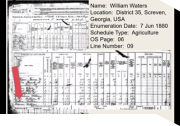All family history researchers should be familiar with nonpopulation census schedules. Population census schedules are what most people think of and use when doing census research, but these other unique census records can contain gold nuggets that help you break through brick walls. Unlock the Mysteries of the Nonpopulation Schedules, presented by Nancy Lee Waters, is a highly useful webinar that will help you learn about this important subject.
Nancy Waters is a researcher, lecturer, college instructor, and award-winning author. She has been a keynote presenter at various genealogical conferences and previously served as the Managing Editor for the Maryland Genealogical Society Journal.
In this webinar, she will guide you to the gold nuggets waiting to be found in nonpopulation schedules.
Here are five questions the webinar answers:
1. Why use nonpopulation schedules in your research?
These records allow researchers to go beyond the traditional population census records research to discover new and colorful data about your ancestors that can bring their stories back to life. As Nancy says, these schedules record information that would otherwise be lost to history.
2. What sorts of nonpopulation record collections are there?
Every nonpopulation collection is unique and unusual. Nancy walks listeners through a wide variety, including agricultural schedules; defective and delinquent classes and schedules; deaf family marriages and hearing relatives; enumeration district maps; manufacturing schedules; mortality schedules; social statistics schedules; special Indian censuses; veterans’ and widows’ schedules; censuses of merchant seamen; and more.
3. Where can you find nonpopulation schedule records?
Since these schedules are typically local and small-scale, they can be far more difficult to track down than traditional genealogical records like censuses. Nancy will guide you to the correct sources to track down all mentioned collections, from various websites to physical archives. She will also teach you how to find other nonpopulation records your ancestors may appear in.
4. What are Nancy’s tips for research success?
This lecture is also a great opportunity to learn some new tricks from a genealogical expert. From using blank census forms to crafting the perfect search terms, following Nancy’s research advice will ensure you leave no stone unturned in your family history quest.
5. How can blank census forms aid with research?
From water damage to tricky handwriting, deciphering hard-to-read records can be difficult and frustrating. Nancy will teach you how to find and use blank census forms to circumvent these issues and to maximize information gleaned from records.
NYG&B members have on-demand access to this webinar.
“Unlock the Mysteries of Nonpopulation Schedules” Outline
The outline below includes an overview of many specific topics covered in the webinar and the approximate timestamps you can use to navigate to each section.
- Introduction and outline from speaker Nancy Waters (03:30)
- Census basics: When it is taken, what questions they asked, who is included (05:44)
- A quick run-through of clues you might find in various censuses (07:35)
- Agricultural schedules: When they were taken, who will appear in them, what information you can glean from them (12:49-20:10)
- Defective and Delinquent Classes and Schedules: What they are, when they were taken (20:10)
- Special Census on Deaf Family Marriages and Hearing Relatives: When and why they were taken (20:51)
- Enumeration District Maps: How to use them, examples (24:15)
- Manufacturing Schedules: When they were taken, what was recorded, examples (25:24)
- Mortality schedules: When they were taken, what was recorded, examples (28:17)
- Slave schedules: When they were taken, which states to find them in, examples (29:31)
- Social statistics schedules: What they are, what was recorded (31:23)
- Special Census of Indians: When they were taken, examples (32:28)
- 1890 Census: Where it was lost, where it survived (34:05)
- Veterans’ and Widows’ Schedule of 1890: What was recorded, example (34:42)
- 1930 Census of Merchant Seamen: Example (37:23)
- 1940 Census (37:42)
- State Census Records: Which states, where to find them, examples (37:49)
- 1950 Census: When it goes public (38:57)
- 2020 Census (39:05)
- Nancy’s search tips: How to search, examples (39:15)
- Where to find records: Archives, websites, etc. (42:24)
- Blank Census Forms: Where to find them and how to use them (44:09)
- References and Conclusion (46:24)
- Question and answer session with Nancy (46:43)
